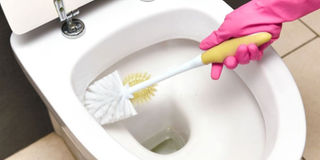Toilet hygiene and the risk of Covid-19

New studies now show coronavirus can spread when one flushes the toilet and some fumes escape into the air. PHOTO/NET
It has been two months since the government started easing the lockdown, allowing different sectors to reopen and people accessing public spaces. Markets, malls and arcades work. Taxis, buses and recently boda-bodas ferry passengers. Hotels and food joints also entertain clients, of course with guidelines to mitigate the spread of coronavirus.
But while it is easier to control the number of clients and employees at a sell point, it is hard to dictate social distancing for people in need of bathrooms when nature calls. Yet in June, scientists found out that flushing the toilet without covering it may spread coronavirus to the next user.
How? Ji-Xiang Wang, study author and colleagues from Yangzhou University, China, said that as water pours into the toilet bowl during flushing, it strikes the side, creating turbulence and droplets so small they float in the air, above head height, for more than a minute.
The study, published in the journal Physics of Fluids, concludes that if those droplets carry the novel coronavirus, the next toilet user might be exposed to it. Ordinarily, coronavirus is spread through airborne droplets from coughs and sneezes, or objects like surfaces contaminated with it.
But scientists around the world are studying sewage and wastewater because people infected with Covid-19 can also have traces of the virus in their faeces. The concern is that other viruses like the ones which cause Hepatitis A and E, can be spread by poor toilet hygiene, known as faecal-oral transmission.
The Ugandan story
Yet in Ugandan (public) toilets, the risk of transmission transcends flushing. One Saturday morning, last month, I went to the washrooms of St. Balikuddembe Market commonly known as Owino. There are 10 rooms for men and 10 for women. The caretaker at the entrance got my Shs300 and handed me a few centimetres of toilet tissue.
He held a piece of soap, from which he pinched tiny pieces to only those interested. The floor and walls begged repair, the wooden doors dirty, rotting away and some do not close. So when you squat, your privacy becomes anyone’s business. After my short call, I crossed to the ladies’ side for a jerrycan to wash my hands. Fortunately, there is a tank overflowing with pipe water. But I had no sooner put the can down than another user picked it. These are the conditions vendors who camped in markets in the wake of the pandemic endured for weeks. The four gents’ rooms and urinaries in the KCCA public toilets at the New Taxi Park are always busy. The caretakers are always draining the water flooding the ceramic floor. The jerrycans are few and the space is congested by those enjoying the free service.
Which toilets and how?
Dr Henry Kajumbula, head of infection control and prevention on the Covid-19 ministerial advisory committee, says in the coronavirus context, pit latrines can be safer because they do not generate aerosols. He adds that squat toilets are less risky because without a bowel, the vortex they form is not so strong to aerosol into the toilet space.
Meanwhile, Najib Bateganya Lukooya, KCCA deputy director public health, says our basic lines of defence against the virus being: minimizing contact, sanitizing and hand washing, the authority is advocating for pedal-flush toilets, where one uses the foot to press the flush button instead of touching it with fingers. “This reduces the risk of spreading or contracting the virus via the flush handle,” he says.
Like in Owino and KCCA toilets, most arcades and some malls in Kampala use jerrycans to flush.
Lukooya says the system which minimises water consumption and maintenance costs, is safe because it does not generate aerosols but it’s risky because many toilet users must touch the flushing jerrycan.
Solution? “The caretaker must disinfect the jerrycans before another user touches it,” he says. He also warns: “And avoid going to the toilet barefoot because germs will touch your skin.”
But what about people with disabilities who crawl into the toilet?
Lukooya says KCCA’s new model of toilets caters for PWDs and reserves rooms for women (especially in their periods). But the project is yet to be implemented and for now, to guard the physically handicapped against infection, he advises that caretakers regularly disinfect the toilet surfaces.
Study
A 2012 World Bank report titled, Economic Impact of Poor Sanitation in Africa, showed that poor sanitation costs Uganda Shs389b each year or 1.1 percent of the country’s Gross Domestic Product (GDP). Open defecation alone, the report says, costs Uganda $41m (about Shs100.4b) and eliminating it would necessitate construction of over 650,000 pit-latrines. Eight years later, according to Lukooya, the most populated district, has only 170, 000 toilets (900 of which public). Early last year government unveiled a plan to build at least five facilities on each highway.




